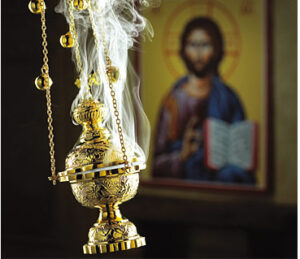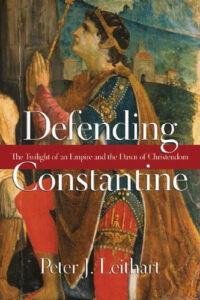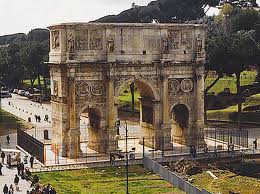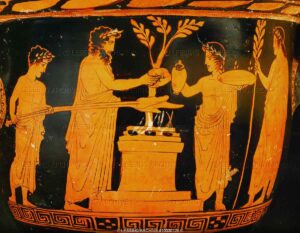
Luther Nailing the 95 Theses
On 22 December 2011, Theodore wrote:
#1 — Granting that the Eastern Orthodox Church (“EOC”) has an ancient tradition, and, further, that its pretty rituals contain much sacred meaning, the fact remains that it is — by its own admission — semi-Pelagian, and, as such, teaches a false religion. Debates about the nature, duration, and content of the service are totally irrelevant when what is presented to the congregation is antithetical to Scripture.
#2 — There are almost too many verses to count in support of Sola Fide, but a good place to start is Luke 18:26-27: “Those who heard it said, ‘Then who can be saved?’ He replied, ‘What is impossible for mortals is possible for God.'” What part of “impossible” is so hard to grasp? There’s no room for synergism here, and, by holding that ANY part of our salvation is the result of our own efforts fundamentally distorts the Gospel, invites the compounding of error, and injects lethal doses of doubt into what should be — in the elect — unshakable, persevering faith.
#3 — In this regard, Mr. Arakaki states: “Salvation in the early Church was both sacramental and evangelical; faith in Christ was necessary in order for God’s grace to be received through the sacraments.” Here please note: 1. Faith comes first, before grace, and, 2. Sacraments — being performed by human beings — are unquestionably “works.”
#4 — Thus, the Eastern Orthodox doctrine of theosis is a sad and ancient error invented by men to satisfy their fallen pride, mistaking the post-justification process of the working out of our sanctification through good works for grace plus works leading to faith and justification, getting it precisely backwards:
#5 — “For by grace you have been saved through faith, and this is not your own doing; it is the gift of God — not the result of works, so that no one may boast. For we are what he has made us, created in Christ Jesus for good works, which God prepared beforehand to be our way of life.” Ephesians 2:8-10. Contrary to the EOC (as stated by Mr. Arakaki, above), here please note: Grace comes first, then faith, followed by GOOD works AFTER we are created in Jesus Christ.
#6 — Whatever else the EOC may get right, such a profound doctrinal error cannot be embraced by a truly Christian church. “But even if we or an angel from heaven should proclaim to you a gospel contrary to what we proclaimed to you, let that one be accursed!” Galatians 1:8.
#6 — Those of you roaming about from denomination to denomination searching for something to make you feel better about yourselves need to grapple with the fact that all the golden robes, gaudy temples, jewel-encrusted icons, clouds of incense and humanly invented theater in the universe are not going to get you any nearer (let alone into!) heaven…
#7 — “Whoever is from God hears the words of God. The reason you do not hear them is that you are not from God.” John 8:47.
My Response
1. Semi-Pelagianism, Theological Benchmarks; Historical Context of Sola Fide
In paragraph #1 Theodore wrote: …the fact remains that it is — by its own admission — semi-Pelagian, and, as such, teaches a false religion.
Historically, the benchmark for theological orthodoxy has been Christology as defined by the Ecumenical Councils. In the early church there were a variety of approaches with respect to soteriology. Prominent in the early church was the understanding of Christ as victorious conqueror over the Devil and Death. There was no one single theory of salvation that became the universal norm required of all Christians. The controversy between Augustine and Pelagius resulted in the condemnation of Pelagianism. At no time did the early church condemn the semi-Pelagian position.
What Theodore has done is to make the Protestant model of soteriology the benchmark for theological orthodoxy. In his broad sweeping condemnation of Semi-Pelaganism Theodore has in effect condemned many of the early church fathers, e.g., Irenaeus of Lyons, Justin Martyr, Athanasius the Great, and many of the Greek Fathers. He has in effect cut himself off from fellowship with the early church.
It is important to note that the term “semi-Pelagian” was not used in the early church. According to the Evangelical Dictionary of Theology (Walter Elwell, ed.) the term was first used in the Lutheran Formula of Concord (1527) and apparently only once.
Theodore’s criticism of the Orthodox Church becomes more problematic when we look closely at the Formula of Concord’s rejection of Semi-Pelagianism. In Article II “Free Will” Negative Thesis 3, we read:
3. We reject also the error of the Semi-Pelagians, who teach that man by his own powers can make a beginning of his conversion, but without the grace of the Holy Ghost cannot complete it (emphasis added).
What we have here is a soteriological paradigm that involves certain assumptions about the Fall, Original Sin, human nature after the Fall, and how we are saved by Christ that are alien to Orthodoxy. For example, Orthodoxy does not teach that man by his “own powers” can “make a beginning” of his conversion. I challenge Theodore to present a church father, a council, or a liturgical text that teaches the Semi-Pelagian position as defined by the Formula of Concord.
The fundamental assumption here that drives the Protestant paradigm is the extreme Augustinian view of the Fall, i.e., that as a result of the Fall man’s capacity to respond to God’s grace was destroyed (see Formula of Concord Article I “Original Sin”, Negative Thesis 6; see also the Second Helvetic Confession chapters VIII and IX). This is the Augustinian interpretation of the Fall. It is the opinion of one church father but it was not part of the universal patristic consensus.
Western Christianity, especially Roman Catholicism after 1054 and later Protestantism, have been heavily influenced by Augustine. When Luther formulated the doctrine of justification by faith alone he introduced a new twist to the Augustinian paradigm. He then went on to make sola fide the core of his theological system and the benchmark for theological orthodoxy. For Luther sola fide was the doctrine on which the church stands or falls (articulus stantis et cadentis ecclesiae). What he did was to turn sola fide not just into a doctrine but a core dogma without which one could not be considered a Christian. Orthodoxy abhors theological innovation and Luther did two things at the same time; he committed heresy by introducing a theological innovation and he committed schism by rejecting those who did not hold to sola fide, e.g., the early church fathers and the Orthodox Church.
Protestants believe that Luther discovered sola fide and in doing so recovered the Gospel, but to the Orthodox Luther invented a doctrine that none of the early church fathers taught. Orthodoxy accepts that we are saved by divine grace and that we are justified by faith in Christ, but it never heard of our being justified by faith alone. The difference is not just in sola fide but in the set of assumptions behind it. Luther came up with sola fide in response to the problems he encountered in attempting to find salvation through medieval Catholicism. This intellectual breakthrough came to be known as Luther’s Tower Experience. Especially problematic for Luther was the Roman Catholic interpretation of Semi-Pelagianism, i.e., facere quod in se est (to do what is in you) (see Alister McGrath’s Iustitia Dei Vol. 2 p. 5). Unlike medieval Catholicism, Eastern Orthodoxy was not confined to Augustinian theology nor was it influenced by Scholasticism’s drive for certainty, precision, and logical consistency. In short, sola fide was one man’s response to a spiritual crisis rooted in the Roman Catholic understanding of salvation. It soon became the basis for a new religious movement known as Protestantism. The longstanding division between the churches of the East and the Church of Rome became further complicated by the emergence of Protestantism and its novel doctrines.
The issue here is not Pelagianism or Semi-Pelagianism. The real issue between classical Protestantism and Orthodoxy is monergism versus synergism. The Orthodox Church unabashedly affirms the synergistic understanding of salvation in Christ: God in his grace reaches out to us and we respond to God’s initiative.
Monergism (mono = one, erg = energy) is based upon a radical understanding of the Fall. According to the monergistic position, because of the radical effect of the Fall, humanity lost any capacity to respond to God’s grace. Augustine of Hippo taught that humans are born under a harsh necessity of committing sin. John Calvin taught that fallen humanity became utterly depraved. This radical understanding of the Fall leads to the position that there is only one key actor in our salvation: God. God alone determines who will or will not be saved. A logical consequence of monergism is the doctrine of double predestination.
Synergism (syn = together, erg = energy) is based upon a less radical understanding of the Fall. According to the synergistic position, Adam and Eve’s sin resulted in our inheriting a corrupted nature. Fallen humanity still possesses free will. While we lack the ability to initiate salvation, we retain the ability to respond to God’s initiative. There are ample citations from the church fathers that show they affirmed our free will in our response to God’s grace. Gregory of Nyssa in The Great Catechism wrote: “For He who holds sovereignty over the universe permitted something to be subject to our own control, over which each of us alone is master. Now this is the will: a thing that cannot be enslaved, being the power of self-determination.” John Chrysostom wrote: “God never draws anyone to Himself by force and violence. He wishes all to be saved, but forces no one.”
Just so there is no confusion: synergism is not the same as Semi-Pelagianism. If Theodore has a bone to pick with Orthodoxy, it is over synergism. There is no evidence of Orthodoxy affirming the Semi-Pelagian position, but there is evidence of it affirming the synergistic understanding of salvation. Theodore will need to show how the Orthodox synergistic understanding of salvation deviates from the historic Christian faith and that its understanding of salvation has been formally condemned by a church council.
I’ve traced the historical context for sola fide in order to lay the ground work for my response to Theodore. My criticisms of sola fide are several. One, it is not part of the catholic (universal) faith of the early church. It is based upon certain individuals, namely Augustine of Hippo and Martin Luther. Two, Semi-Pelagianism was never condemned by the early church. Three, the doctrinal standard for the early church was Christology, not soteriology. Four, Luther had no authority to make sola fide into a dogma, only an ecumenical council has the final say on dogma.
Theodore, you cannot just use a label like “Semi-Pelagianism” to condemn Orthodoxy. You need to use an appropriate benchmark for showing on what basis Orthodoxy is wrong. I will readily agree with you that the Orthodox Church is not in agreement with Luther; that is because Orthodoxy is based on the theology of the early church. We cannot accept a sixteenth century theological innovation. You need to show that sola fide was taught in the early church and that it was used as a standard for theological orthodoxy. Unless you can do so, I remain of the opinion that you are using as a theological benchmark a standard alien to the early church. Either Luther’s sola fide is a theological novelty or it is part of the ancient Christian faith. I have presented evidence for the former; I invite you to present evidence for the latter position.
One last note, by condemning Orthodoxy as a “false religion,” you are at the same time condemning the early church as a “false religion.” Are you sure you want to take that extreme stance?
2. Biblical Teachings on Justification by Faith
In paragraph #2 Theodore cites Luke 18:26-27 to defend sola fide. I’m surprised by his choice of passages. In this encounter between Jesus and the rich young ruler neither the issue of justification nor faith are brought up. One would need to do quite a bit of eisegesis (reading into the text) to arrive at the conclusion that the doctrine of sola fide is being taught here. Furthermore, if one wishes to use this passage to rebut the doctrine of synergism then one must also take into account the following chapter in which the encounter between Zaccheus and Jesus results in Zaccheus giving up his wealth (Luke 19:8-10).
If Theodore wishes to present the biblical basis for the Protestant sola fide he would be better off discussing Paul’s letter to the Romans where faith and justification by faith are clearly discussed. All he needs to do is point to at least one verse where the phrase “faith alone” is used explicitly, not inferred. A doctrine can be inferred from Scripture but it is dangerous to base a fundamental dogma on an inferred understanding of Scripture. Likewise, Theodore needs to take into account the one place where phrase “faith alone” (pistis monon) is used in Scripture, that is, James 2:24. “You see then that a man is justified by works, and not by faith only (pisteos monon) (NKJV).”
I was amused when in paragraph #3 Theodore infers that I was asserting that faith came first before grace. This obsession with chronological order is characteristic of theological scholasticism in the West. Theodore’s dismissive claim of baptism as “works” strikes me as a simplistic and extreme understanding of sola fide that is alien to Lutheran theology. According to Luther’s Small Catechism Article IV baptism is not just a symbol but a sacrament that “effects forgiveness of sins, deliver from death and the devil, and grants eternal salvation to all who believes….” This understanding of baptism is very much like that of the Orthodox Church.
In paragraph #5, Theodore writes: …here please note: Grace comes first, then faith, followed by GOOD works AFTER we are created in Jesus Christ. The Orthodox position is not that one precedes the other but that faith and works go together, work together (synergy). This synergistic interaction between faith and works is taught in James 2:22. The Greek word synergei is used in this verse. “Do you see that faith was working together (sunergei: syn = with, together; ergei = to work, to do) with his works, and by works faith was made perfect? (NKJV).”
3. Theosis – Becoming Like Christ
In paragraph #4 Theodore criticizes the doctrine of theosis. He writes: Thus, the Eastern Orthodox doctrine of theosis is a sad and ancient error invented by men to satisfy their fallen pride, mistaking the post-justification process of the working out of our sanctification through good works for grace plus works leading to faith and justification, getting it precisely backwards….
First, he must address the fact that theosis has a biblical basis. It is taught in II Peter 1:3-4 which talks about our becoming “partakers of the divine nature.” This is not an isolated passage but one that complements other similar teachings about our ultimate glorified state. In Romans 8:29 Paul writes about our being conformed to image of Christ. In I John 3:2 John writes that at the Second Coming of Christ, “we shall be like Him.”
Second, the doctrine of theosis was taught by early church fathers like Athanasius the Great. In the theological classic On The Incarnation, Athanasius wrote: “He, indeed, assumed humanity that we might become God (§54).”
Third, the doctrine of theosis has been given a more friendly reception by Reformed scholars recently. I refer you to W. Bradford Littlejohn’s Mercersburg Theology and the Quest for Reformed Catholicity. You can read my review of his book here. I would caution Theodore against uncritically repeating the party line. Reformed theology is complex and nuanced than many have thought it to be. The same can be said for Orthodox theology. I would urge Theodore to examine the evidence and arguments before passing judgment on another religious tradition.
Fourth, one must be careful about resorting to ad hominem attacks or imputing impure motives to those who hold to a certain belief. His accusation that theosis was “invented by men to satisfy their fallen pride” is an ad hominem attack. Furthermore, it claims to know the inner motives of those who hold to it. Theodore would be better off presenting biblical and historical evidence showing that Scripture repudiates theosis and that the early church likewise rejected this teaching. One cannot uncritically repeat what one has learned from secondary sources.
4. Hurling Anathemas
I recognize that there are significant differences between Eastern Orthodox and the Reformed traditions. I constructed this site as a place where the two sides can learn from each other. It is not constructive to come out announcing anathemas without having first engaged the other side. If both sides hurled anathemas preemptively then we won’t be building bridges but rather walls of silence and hostility. Theodore, what is your intent in citing Galatians 1:8? Wouldn’t it be better to build bridges?
As a former Evangelical and one who studied at a conservative Reformed seminary I am quite familiar with Galatians 1:8. I would like to note that one cannot just cite Galatians 1:8 and be done with that. The controversy that the Apostle Paul had with the first century Judaizers was very different from the controversy between the sixteenth century Roman Catholics and Protestants. Theodore needs to show how the situation in Galatians applies to the actual (not alleged) teachings of Eastern Orthodoxy. The absence of citations from authoritative Orthodox sources makes me wonder how familiar he is with the Orthodox Church. Without this informed understanding Theodore risks sounding like a Bible thumper. I am confident that he can present a more balanced and nuanced argument.
5. Reasons for Converting to Orthodoxy
It is disturbing to find a personal attack in paragraph #6. Theodore writes: Those of you roaming about from denomination to denomination searching for something to make you feel better about yourselves need to grapple with the fact that all the golden robes, gaudy temples, jewel-encrusted icons, clouds of incense and humanly invented theater in the universe are not going to get you any nearer (let alone into!) heaven…
It may be that some people are drawn to Orthodox worship because of its rich aesthetics but a stronger case can be made from Scripture. We find in Exodus chapters 25 to 40 God giving Moses instructions for the construction of the Tabernacle. The instructions called for an ornate place of worship that included heavily decorated vestments, images of angels worked into the curtains, and incense. If Orthodox liturgical worship is patterned after the Old Testament worship how can one claim that it is not biblical? Rather one must raise the question whether or not it is the Reformed churches who have abandoned true biblical worship with their bare four walls and ministers who wear robes patterned after that of university professors.
Reformed Worship vs. Biblical Worship

Burning Incense
I have two questions for Theodore in closing. In Malachi 1:11 we read: “For from the rising of the sun even to it going down, My name has been glorified among the Gentiles; and in every place incense shall be offered to My name, and a pure offering, for my name shall be great among the Gentiles (NKJV).” Here we have a prediction that when the Christ comes incense would be a sign of worship in the Messianic age. The incense offered in Jewish worship would be offered by the Gentiles in the age to come. Does your local church offer incense during its worship? If your church does not offer incense, why has it abandoned the biblical pattern of worship?
In Hebrews 13:10 we read: “We have an altar from which those who serve the tabernacle have no right to eat (NKJV).” The early Christians believed that Christ’s death on the cross was the fulfillment of the Jewish sacrificial system. The Jewish priests were not allowed access to the Eucharist because they did not recognize Jesus as the Messiah. Historically, Christian churches had an altar where the Eucharist was celebrated in the Sunday liturgy. Does your church have an altar? Does it celebrate the Eucharist every Sunday as in the case of historic Christian worship? If your church does not follow the historic pattern, why has it abandoned the historic pattern of worship?
Robert Arakaki








Recent Comments